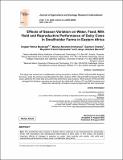| dc.description.abstract | Aim: The smallholder dairy industry in Eastern Africa continues to be characterized by seasonality driven milk fluctuations and reproductive performance of dairy cows. In this review, we present important effects of changes in seasons on water, feed quantity and quality, milk yield and reproductive performance of dairy cows in smallholder dairy farms.
Methods: We considered peer-reviewed publications from 1990 to 2019, and extracted any information pertaining to the effects and intensity of changes in seasons and implications on water, feed quality and quantity, milk yield and reproductive performance.
Results: Seasonal variation in rainfall, characteristic of the East Africa region, is strongly reflected in cropping and feeding calendars. Hence, 305-days lactation milk production per cow in Eastern Africa ranges from 850-3150 kg/cow/year, which has not increased, partly because of lack of improvement in nutrition and management, but also due to slow genetic selection of breeds that matches available feed to milk yield and reproductive performance. High milk fluctuations arise mostly because of farmers’ dependence on rainfall for feed production and rarely make provisions for preserving fodder for the dry season, as there isn’t adequate forage (fodder and pasture) even during the wet season.
Conclusion: For the smallholder dairy farmers to remain competitive, it is important to increase the dairy value chain capability to manage implications of changes in seasons on milk yield and reproduction. Therefore, in order to overcome the current seasonal changes, we have discussed technological interventions in adoption of practical, sustainable farmer-led strategies for optimizing water and feed production, milk yield and reproductive performance in Eastern Africa. We have also identified knowledge gaps where research is needed to guide dairy value chain stakeholders on how to ameliorate current seasonal changes or that we expect will occur in the future. | en_US |

